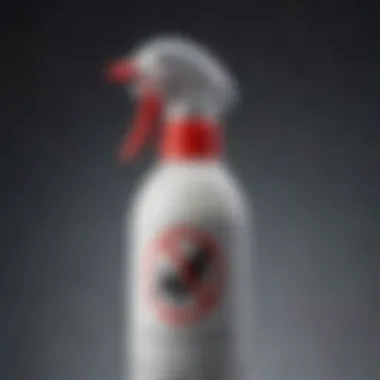Understanding Anti-Pigeon Spray: A Comprehensive Guide


Intro
The issue of pigeons in urban and suburban settings has become increasingly common, prompting residents to seek various solutions. Commonly perceived as pests, pigeons can cause property damage and hygienic concerns. Among the tools available for managing pigeon populations, anti-pigeon spray has emerged as a widely discussed option. This article provides a comprehensive understanding of anti-pigeon spray, examining its effectiveness, the different formulations available, and the ethical implications surrounding its use. The aim is to assist homeowners in making informed decisions regarding this pest control method.
Pest Identification
Understanding the problem starts with identifying the pest. Pigeons belong to the family Columbidae. They are medium-sized birds often found in urban areas, where food is plentiful.
Common Household Pests
While pigeons are the focus here, it’s useful to recognize they exist among other common household pests such as:
- Rats
- Mice
- Cockroaches
- Ants
Signs of Infestation
Detecting a pigeon problem requires careful observation. Common signs include:
- Droppings accumulating on surfaces.
- Nest debris found on ledges or near entrances.
- Sightings of pigeons roosting or nesting in undesirable locations.
- Noise from cooing or fluttering.
Recognizing these signs is the first step in addressing the presence of pigeons effectively. This leads nicely into exploring preventive measures.
Prevention Methods
Preventing pigeon infestations can often be more effective than managing them once established. Here are some key strategies:
Environmental Modifications
Making slight changes to the environment can deter pigeons from settling:
- Seal off potential nesting areas, such as ledges and awnings.
- Remove accessible food sources by keeping garbage in secured containers.
- Install bird spikes or netting in areas where pigeons tend to gather.
Home Maintenance Tips
Regular maintenance plays a crucial role:
- Inspect for and fix any holes in roofs or walls.
- Clean gutters and drains regularly to avoid build-up that can attract pests.
- Trim trees or shrubs that offer perching places.
By implementing these preventive steps, homeowners can reduce the likelihood of a pigeon infestation before it begins.
DIY Pest Control Solutions
Homeowners often consider do-it-yourself methods when dealing wth pests. There are various approaches available for managing pigeons without professional help.
Natural Remedies
Some natural deterrents include:
- Using peppermint oil, which can repel pigeons with its strong odor.
- Spraying a vinegar and water solution in areas where pigeons tend to gather.
- Setting up motion-activated sprinklers to scare birds away.
DIY Traps and Barriers
In addition to repellents, physical barriers can also be effective:
- Simple nets can trap pigeons if positioned correctly.
- Old CDs or reflective materials can be hung to create movement and light, which often scare pigeons away.
Utilizing DIY approaches provides a sense of control and avoids the issues associated with chemical deterrents.
"Understanding the mechanism behind anti-pigeon spray is crucial for its effective use, alongside ethical considerations."


This guide will delve deeper into anti-pigeon spray formulations, safety concerns, and broader ethical implications in the subsequent sections. By being informed, homeowners can navigate the complexities of pigeon management with greater confidence.
Prelims to Anti-Pigeon Spray
The issue of pigeons in urban environments has drawn significant attention in recent years. Their presence can lead to various problems, from property damage to health risks. Understanding how to manage these birds effectively is crucial for homeowners and property managers alike. Anti-pigeon spray has emerged as one of the prominent methods for controlling pigeon populations.
This comprehensive guide aims to shed light on anti-pigeon spray, its formulation, usage, and overall impact. By exploring the benefits and implications associated with these products, readers can make informed decisions. Moreover, we will discuss potential safety concerns, the evolution of pigeon control methods, and how they fit into the broader context of pest management.
The relevance of understanding anti-pigeon spray is underscored by the need for practical solutions to persistent challenges. It is essential for those living in areas where pigeons are a nuisance to grasp the underlying principles that guide the effectiveness of these sprays.
Defining Anti-Pigeon Spray
Anti-pigeon spray is a chemical formulation designed to deter pigeons from specific areas. These sprays typically contain active ingredients that either create an unpleasant environment for the birds or directly affect their behavior. The precise composition can vary between products, but the goal remains consistent: to prevent pigeons from roosting, nesting, or feeding in targeted spaces.
Users find anti-pigeon spray effective in various settings such as residential homes, commercial buildings, and public spaces. Homeowners may apply these products to balconies, patios, or ledges where pigeons tend to gather. The ease of application and immediate results contribute to the popularity of these deterrents.
The Evolution of Pigeon Control Methods
Historically, pigeon control methods have evolved significantly. In the past, physical deterrents like spikes and nets were common. While these methods have their merits, they often lack the practicality needed for widespread application.
As urban environments changed, so did the need for more efficient solutions. With advancements over time, chemical repellents emerged as a favorable option. The development of anti-pigeon sprays reflects a shift towards more targeted approaches that prioritize convenience and effectiveness.
Today, homeowners have a range of options, including both chemical sprays and non-chemical alternatives, enabling them to choose strategies based on effectiveness, safety, and ethical considerations. Understanding this evolution is key to appreciating the place of anti-pigeon sprays in modern bird management.
Mechanisms of Action
Understanding the mechanisms of action behind anti-pigeon spray is crucial for effective pigeon management. This section will unravel the science behind these sprays and how they function to deter pigeons from certain areas. This knowledge informs not only their application but also their role in the broader spectrum of pest control strategies. With a clearer grasp of these mechanisms, homeowners can make educated decisions about which products to select and how to implement them in their environment, ensuring a safer and more effective solution.
Chemical Composition
Anti-pigeon spray typically contains a mixture of chemicals designed to repel birds. Common ingredients include capsaicin, which is derived from hot peppers, and various essential oils. These components work by creating an unpleasant sensory experience for pigeons. Capsaicin can irritate the mucous membranes in their throat, causing discomfort. Essential oils, like citronella or peppermint, have strong scents that are bothersome to birds, making treated areas less appealing.
The effectiveness of the spray may vary depending on its specific formulation. Some manufacturers promote their products as biodegradable and safe for the environment. Homeowners should be aware that different formulations might have distinct levels of effectiveness against pigeons. Thus, it can be beneficial to examine product labels critically and consider user reviews for insights into performance.
How It Affects Pigeons
When pigeons encounter anti-pigeon spray, they experience immediate discomfort. The aversive chemicals create a strong, negative reaction. This reaction is vital for repelling them. For example, if a pigeon senses a bitter taste or an irritating smell, it will likely avoid the area in the future. This forms the basis of the behavioral conditioning that anti-pigeon sprays leverage.
Notably, the efficacy of these sprays may diminish over time, especially with repeated exposure. Pigeons are intelligent birds and can adapt to their environment. Therefore, homeowners may need to reapply spray regularly to maintain its deterrent effects. Understanding this aspect is crucial in developing a long-term management strategy that combines chemical deterrents with other methods.
Effectiveness of Anti-Pigeon Spray
The effectiveness of anti-pigeon spray is crucial in determining its utility for homeowners facing pigeon-related issues. Pigeons can be a major nuisance, causing property damage and hygiene concerns. Therefore, understanding the factors that contribute to the efficacy of these sprays can significantly impact their successful implementation. Evaluating effectiveness involves both the specific conditions under which the spray is applied and the particular formulation of the product used. Effective anti-pigeon sprays can potentially decrease pigeon populations in urban areas, thus providing a more pleasant living environment.
Factors Influencing Effectiveness
Several factors can influence the effectiveness of anti-pigeon sprays. These include:
- Environmental Conditions: Temperature, humidity, and wind can alter how sprays behave. For example, high humidity may dilute the spray, reducing its efficacy.
- Application Technique: Proper application is essential. Sprays must be applied according to the manufacturer's guidelines to achieve maximum effectiveness. Inconsistent application can lead to uneven coverage, making certain areas attractive to pigeons.
- Pigeon Behavior: Pigeons are intelligent birds. If they consistently encounter deterrents, they may become accustomed to them, diminishing the spray’s effectiveness over time.
- Frequency of Application: Regular reapplication is necessary. The active ingredients in many sprays can degrade or become less effective when exposed to the elements. A consistent schedule must be kept to maintain deterrence.
- Formulation: Different sprays have different chemical components. Some may work better in urban settings, while others may be more suited for rural areas. Focused research into product composition is vital.
Using these factors as a guideline can help homeowners achieve better results with anti-pigeon sprays.
Comparison with Alternative Methods
In evaluating the effectiveness of anti-pigeon sprays, it is essential to compare them with alternative methods of pigeon control. Options such as physical barriers, traps, and non-chemical repellents can be utilized, each having advantages and downsides:
- Physical Barriers: Netting or spikes can physically prevent pigeons from accessing specific areas.
- Traps: Live traps can capture pigeons humanely. However, relocation may be problematic since it does not address the root cause.
- Non-Chemical Repellents: These include sound devices or visual deterrents like decoys.
- Advantage: Permanent solution once installed.
- Disadvantage: Can be costly and may alter the appearance of structures.
- Advantage: Humane approach eliminating the need for chemicals.
- Disadvantage: Time-consuming and labor-intensive.


- Advantage: Can be environmentally friendly and easy to set up.
- Disadvantage: Often require ongoing maintenance and may not guarantee results.
Ultimately, the best approach might combine anti-pigeon sprays with these alternative methods, creating a comprehensive pigeon management strategy. Homeowners need to assess their specific situations to select the best solution.
Application Techniques
The application techniques used for anti-pigeon spray are vital. They directly impact the effectiveness of the product and safety for users, pigeons, and other wildlife. Proper techniques ensure targeted delivery of the spray and minimize environmental risks.
Preparation Before Application
Before applying an anti-pigeon spray, thorough preparation is crucial. Consider the following steps:
- Choosing the Right Product: Different sprays contain unique chemical compositions. Research each product's specifics to match your situation.
- Reviewing Instructions: Always read the manufacturer's guidelines. This will teach you about dilution rates, recommended surfaces, and specific applications environments.
- Safety Gear: Wear necessary protective equipment. Gloves, masks, and goggles help protect against skin contact or inhalation.
- Clear the Area: Remove people, pets, and obstacles from the application site. Ensure pigeons are not in the immediate vicinity during application.
- Weather Conditions: Avoid applying spray during windy or rainy conditions. This prevents drift and ensures the solution remains effective on targeted surfaces.
By preparing adequately, you ensure a safer and more effective application of anti-pigeon sprays.
Proper Application Techniques
Correct application techniques significantly enhance the efficiency of anti-pigeon sprays. Here are some essential points to consider:
- Use of Equipment: Depending on the area size, select the appropriate sprayer. A backpack sprayer works for larger spaces, while a simple hand-held sprayer suits smaller areas.
- Application Technique: Hold the sprayer at a consistent distance from the surface, usually around 12 to 18 inches. Apply the spray in even, sweeping motions to cover the target area completely.
- Layering: If necessary, multiple thin layers are preferable to one thick coat. This maximizes effectiveness and reduces runoff.
- Timing: Apply spray during cooler parts of the day, such as early morning or late afternoon. Avoid peak sunlight to ensure the active ingredients remain effective.
- Check Residue: After application, examine the area for any remaining residue. If needed, reapply to ensure the deterrent effect is upheld.
Following these application techniques enhances not only the product's effectiveness but also contributes to a safer environment for all inhabitants.
Safety Concerns and Regulations
The use of anti-pigeon sprays raises important safety concerns and regulatory considerations. This section aims to unpack these elements to ensure that homeowners and pest control professionals understand the implications of using such products. Knowledge of safety regulations helps in protecting not just the users but also their environment.
Potential Risks to Humans and Pets
When applying anti-pigeon sprays, the primary concern is the potential risks they pose to humans and pets. Most sprays contain active ingredients that can be harmful if ingested or inhaled. Common symptoms of exposure can include respiratory problems, skin irritation, and gastrointestinal issues.
Here are some of the potential risks:
- Respiratory Problems: Inhalation of sprays can lead to breathing difficulties, especially in individuals with pre-existing respiratory conditions.
- Skin Irritation: Direct contact with skin can cause rashes or allergic reactions, necessitating appropriate protective gear during application.
- Pet Safety: Pets, particularly curious dogs and cats, may come into contact with treated areas, risking exposure to harmful chemicals.
For these reasons, it is essential to read all labels and safety data sheets carefully. Ensuring that the area is well-ventilated and that humans and pets are kept away during and after application can mitigate some of these risks.
Proper usage is critical. Always follow manufacturer’s directions for application and safety.
Environmental Considerations
The environmental impact of anti-pigeon sprays is another significant aspect to consider. Many formulations can have unintended effects on local ecosystems. Chemical runoff can contaminate soil and waterways, affecting non-target species. Understanding the implications can help homeowners make informed decisions about using these products.
Relevant environmental concerns include:
- Effects on Non-target Wildlife: Some chemicals may also harm birds and other wildlife. Understanding the breakdown processes of the chemicals used in sprays can provide insight into their longevity in the environment.
- Pollution: Effectively managing where and when to apply these sprays can prevent unnecessary pollution and protect sensitive habitats.
- Sustainable Practices: Alternatives and integrated pest management strategies can reduce reliance on chemical deterrents.
Addressing this issue requires not only awareness of the chemicals used but also an ethics of care towards nature. Homeowners should consider methods that suit their pest control needs while being environmentally conscious. This will also help align with local regulations governing pesticide and herbicide use.
Ethical Considerations Regarding Use
Ethical considerations regarding the use of anti-pigeon spray are increasingly relevant in today's discussions about pest control. As homeowners confront the nuisance of pigeons, the methods chosen to manage these populations must be analyzed through an ethical lens. This ensures that effective pest control does not come at the expense of animal rights or environmental health. In this section, the focus will be on key elements such as balancing the necessity of pest control with respect for animal welfare. It will also delve into public opinions on chemical deterrents, providing a comprehensive understanding of the complexities involved.
Balancing Pest Control with Animal Welfare
When discussing pest control, it is crucial to find a balance that acknowledges both human needs and animal welfare. Pigeons, often labeled as pests because of their droppings and potential to carry diseases, have a right to humane treatment. Anti-pigeon sprays can effectively deter these birds, but the formulation and application of such sprays must consider their impact on the pigeons’ health.
Homeowners should prioritize choosing products that are vetted for safety and effectiveness while minimizing harm to non-target species. Understanding the chemical composition can aid in selecting humane options. This commitment to responsible use promotes a conscientious approach, ensuring that wildlife is treated with respect.


- Humane Treatment: Always research the specific formulations of anti-pigeon spray. Opt for those made with non-toxic ingredients that target pigeons without causing them harm.
- Zero Tolerance: Recognize the importance of controlling pigeon populations without resorting to lethal means. Effective management often leads to healthier urban environments, where both humans and animals can coexist.
Public Opinion and Perspectives
Public opinion plays a significant role in shaping the approaches taken toward pigeon management. Many individuals express a deep concern for animal welfare, advocating for the use of more humane pest control methods. The debate surrounding anti-pigeon sprays often centers on their ethical implications. Some argue that these sprays can contribute to suffering, while others maintain that they offer vital solutions for urban living.
Understanding these perspectives can provide insight into community attitudes and help guide responsible practices.
- Local Attitudes: In urban areas, discussions around pigeon control methods often reflect a tension between the need to keep public spaces clean and the desire to protect animal rights. Collecting feedback from community stakeholders can inform better practices.
- Advocacy Groups: Organizations focused on animal welfare often influence public opinion. Their activism can lead to increased transparency in the formulation and marketing of anti-pigeon products, encouraging developments that respond to societal concerns.
"The delicate balance between pest control and animal welfare is crucial in today’s society. Striking this equilibrium can lead to more sustainable and humane solutions."
In summary, ethical considerations surrounding the use of anti-pigeon spray are essential in shaping responsible pest management practices. By balancing effective control with animal welfare and acknowledging public concerns, homeowners can make informed decisions that positively contribute to their communities.
Long-Term Management Strategies
Effective pigeon control requires a comprehensive approach that goes beyond short-term fixes. The relevance of long-term management strategies lies in their ability to create sustainable environments where pigeon populations are kept in check. A single application of anti-pigeon spray can be effective temporarily, but without ongoing measures, pigeons can quickly return. Therefore, these strategies are essential in maintaining a balance between the needs of homeowners and the wellbeing of wildlife.
Some specific elements of long-term management include habitat modification, exclusion practices, and continued monitoring of pigeon populations. These components work together to form a comprehensive plan that is adaptable to changing conditions.
Benefits of Long-Term Management Strategies
- Sustainability: These strategies invest in long-term solutions rather than quick fixes.
- Cost-Effectiveness: By addressing the root causes of pigeon infestation, homeowners can save money on repeated treatments.
- Public Health: By managing pigeon populations responsibly, communities can reduce the risk of diseases associated with these birds.
Considerations about Long-Term Management
Engaging in long-term management requires commitment and some initial investment in time and resources. Homeowners must evaluate their environment and practices to effectively integrate these strategies. It may also involve collaboration with pest control professionals, enabling access to expert knowledge and tailored solutions that suit individual needs.
Integrating Chemical and Non-Chemical Methods
Combining chemical deterrents like anti-pigeon sprays with non-chemical methods presents a well-rounded approach to pigeon management. This dual strategy takes advantage of the immediate effectiveness of sprays, while also addressing underlying issues that attract pigeons.
Non-chemical methods may include:
- Physical Barriers: Installing netting or spikes on ledges to prevent landing.
- Behavioral Deterrents: Using noise makers or visual scares to discourage pigeons from frequenting certain areas.
- Removal of Nesting Sites: Regularly checking for and removing nests, thus denying pigeons safe refuge.
Using both methods allows for flexibility. Depending on the specific situation, a homeowner can determine which approach is more suitable. While sprays can provide immediate results, physical alterations to the environment can reduce future attraction, making the area less appealing to pigeons.
Monitoring and Assessing Outcomes
Regular monitoring and assessment of pigeon activity and the effectiveness of the implemented strategies are crucial. Data collection allows homeowners to identify patterns in pigeon behavior and pinpoint successful methods.
Here are some key steps to consider:
- Establish Baselines: Document the initial severity of pigeon problems. This helps gauge the success of your strategies later.
- Frequency Checks: Regularly observe and record pigeon presence over time. Use a simple checklist to note when pigeons appear or how they interact with deterrents.
- Evaluate and Adjust: If certain methods are not yielding desired results, be ready to adapt. Experiment with different combinations of methods until you determine what works best.
"Continuous monitoring not only aids in assessing outcomes but also allows for proactive adjustments that can significantly improve strategies over time."
By focusing on these aspects, homeowners can ensure that their efforts lead to meaningful and sustained reductions in pigeon populations. Overall, integrating various methods and regularly assessing their effectiveness contribute significantly to effective pigeon management.
Ending
The conclusion of this article serves to encapsulate the multifaceted aspects of anti-pigeon spray and its broader significance in effective pest management. As discussed in the previous sections, the mechanisms behind these sprays, their effectiveness, potential risks, and ethical considerations all contribute greatly to understanding their role in urban settings. It is essential to recognize that pigeon control is not just about addressing immediate concerns. It involves a holistic approach that encompasses environmental, safety, and ethical factors.
Summary of Key Insights
Throughout this guide, we have delved into the various aspects of anti-pigeon spray. Here are the key takeaways:
- Definition and Evolution: Anti-pigeon sprays emerged as a practical solution amid a range of traditional methods, showcasing advances in pest control technology.
- Mechanisms of Action: The chemical composition of these sprays plays a critical role in combating pigeon presence, often targeting sensory responses rather than causing harm.
- Effectiveness and Application: Proper application techniques are vital for success. Factors influencing effectiveness include environmental conditions and the specific formulation used.
- Safety and Ethical Concerns: Understanding potential risks to humans and pets, alongside environmental impacts, is crucial in fostering responsible use of chemical deterrents.
- Long-Term Strategies: Integrating both chemical and non-chemical management strategies offers a more balanced approach to sustainability. Monitoring the results can help homeowners adapt their methods effectively.
Future Directions in Pigeon Management
Looking forward, the trends in managing pigeon populations are likely to reflect growing concerns regarding sustainability and animal welfare. Considerations for future methodologies may include:
- Research and Development: Continuous advancement in formulations that are less harmful to non-target species will be vital. These innovations can enhance their appeal in residential areas.
- Community Education: Raising awareness about the importance of responsible bird management can shift perspectives and encourage cooperation among homeowners.
- Policy and Regulation: Regulatory frameworks that emphasize safe use while minimizing environmental impact could help standardize practices across regions.
- Integration of Technology: Smart solutions using technology to monitor pigeon activity and automate deterrent usage could emerge as an effective technique for urban dwellers.
In summary, the effective management of pigeons, aided by anti-pigeon sprays, presents a complex blend of challenges and opportunities. By understanding these dimensions, homeowners and pest control professionals alike can work towards sustainable solutions that prioritize safety and responsibility.















